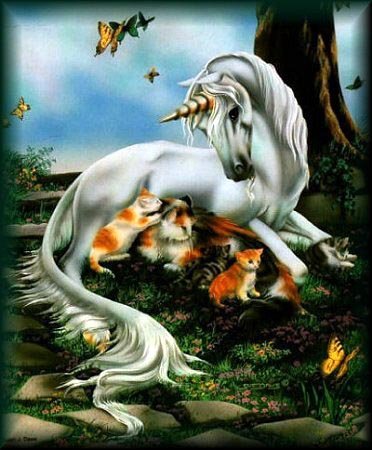|
The Norwegian
Forestcat |
|
 |
|
The Norway national
cat, which goes back to the days of the Vikings. |
|
The big strong cat,
with it´s bushy tail and waterresistance, semilong coat, which the
Norwegian nature, for centuries, without mercy, created. And nature made
sure that only the strongest survived cold, snowstorms, ice and rain and
continued to make the breed stronger and better adapted to survive, such
as; a special coat with thick underwool to keep them warm, with long water
resistant guardhairs on the back, hanging down the sides, to keep them dry.
|
|

EC/WW N* Flatland's
Bjørnstierne, DM
©??? |
|

EC+GIP N* Pan's Polaris, DM
©???
|
|
To protect the most sensitive parts of the body a bit extra, these got
longer coat, as collar, eartufts, tufts between their toes, also the
cheeks and breast got a longer coat, and the long tail.
Big and strong, on
high legs, with the hind legs slightly higher than the frontlegs, the
Forest cat moves like an athlete and is extremely good in climbing trees,
and in fact, almost as good in getting down again, with their heads first! |
|
|
The Forestcats
head reminds us about the Lynx. With big ears with tufts on, the
expression in the eyes, the strong chin and the straight profile, gives a
very strong impression of wild cat and wilderness.
Now you are asking yourself - can
I really keep these cats as a pet indoors?
The answer is, without any doubts, YES. |
|

EC DK* Flødekaramel Felis
Jubatus, DM
©Martin Kristensen
|
|
 |
|

© Sue Dawe |
|
The Forest Cat is a social, friendly cat, who likes both humans and other
cats. Just like other cats, the Forest Cat has a great personality. They
are also very intelligent and "speaks" a lot, without being noisy. (Most
Forestcats prefer a catcompanion instead of being a single cat.)
The coat is, inspite of it´s length, quite easy to care for, but in the
shedding season they can get some smaller knots. During summer, the cats
are almost shorthaired, the only thing that make you realise it´s not, is
the tail, and the "knickers" (back of hindlegs), who still have long fur.
The tales about the Forest Cat are many and it´s mentioned in litterature
in very early days. |
|
|
 |
|
In Oslo 1938 the first Forest Cat was shown and judged by a very excited
judge, named Knut Hansen. Then the second World War broke out and the work
to preserve this Norwegian nationalbreed didn´t start again until 1972.
the year after -1973- the breed was recognized in Norway, after the
Norwegian catpeople agreed on a standard.
The cats were given pedigrees as an experimental breed, and 1976, the
Norwegians had about 100 cats registered. The same year, on FIFE´s annual
meeting in Wiesbaden, the Norwegian Forest Cat got recognized without
certificate status. |
|
|

Pan's Truls
|
|
But the Norwegian people didn´t give up. When FIFE had it´s annual meeting
in Paris 1977, Fredrik Nordane and several others where present, bringing
with them a lot of photomaterial and pedigree documentation, showing 3
generations of Forest Cats. And this time they succeded, the Norwegian
Forest Cat was officially recognised! This event even was covered by the
Norwegian TV-news, and the Norwegian people are proud of their National
breed, and so they should be!
There have been a big interest for the Forest Cat in Sweden, right from
the start, but as the Norwegians first wanted to create a good
breedingbase for themselves, only cats from third or fourth generations
was allowed to be sold out of Norway. But 1977 the first Forest Cat came
to Sweden from Norway and many cats have followed him since then and
nowadays the Swedish NFO´s are just as good as the Norwegians.
© by
Skogkattslingan
2005
|
|
|
 |
|
WCF-Standard
of the Norwegian Forestcat
|
|
Body:
|
Medium to
large sized cat, long strong body with solid bone structure; long and
sturdy legs,
hind legs longer than front legs; broad round paws with heavy tufting
between toes; very
long and bushy tail, at least as long as the body. |
|
Head:
|
In the shape
of an equilateral triangle; long, straight profile; strong chin.
|
|
Eyes:
|
Large, open,
slightly oval; eye colour to be uniform and harmonizing with the coat
colour.
|
|
Ears: |
Very large,
wide at the base and set high on the head, the line of the head should
follow the
outer lower edge of the ear straight down along the cheek. With lynx-like
tufts and long hair
out of the ears. |
|
Coat:
|
Semi-long; the
woolly undercoat is covered by long, glossy, firm and water-repellent
guard hair.
The overcoat covers the back, flanks and the upper side of the tail
completely. The underside of body and back side of hind legs have only
undercoat. A long ruff, a triangular shaped beard
hanging down the cheeks and breeches on the hind legs make the picture
complete. |
|
Colour
Varieties: |
Chocolate and
cinnamon and the according diluted colours (lilac and fawn) are not
accepted in
any pattern combinations (bi-colour, tri-colour, tabby). Also, the c s
-factor is not accepted.
Any other colour is accepted, the descriptions of colours are listed in
the General Colour Guide.
Any amount of white is allowed. |
|
Faults:
|
Dry, matted
coat; silky texture. |
|
Scale of Points: |
|
Type: |
25 Points |
|
Head:
|
20 Points
|
|
Eyes: |
5
Points
|
|
Ears: |
10 Points
|
|
Tail: |
10 Points
|
|
Colour and Pattern: |
5 Points
|
|
Coat Texture: |
20 Points |
|
Condition: |
5 Points
|
|




